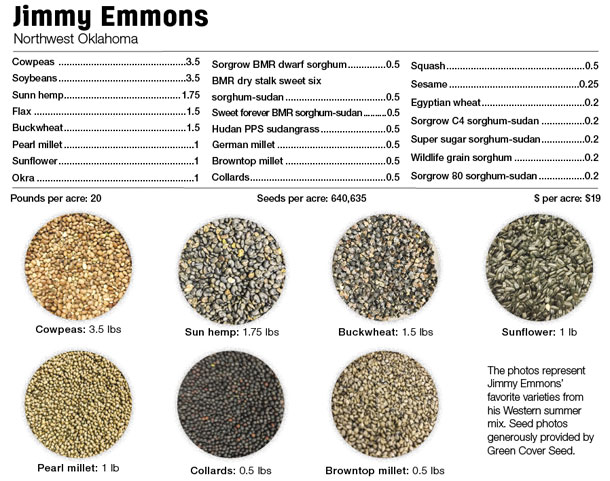Jimmy Emmons isn’t afraid of trying something new when it comes to his cover crop mixture. Over the past seven years, Jimmy has been developing a diverse cover crop mixture to plant between each of their five cash crops currently in rotation.
Click here or on the image above to view it at full size in a new window.
“We started seven years ago after I went to a conference and heard Dave Brandt from Ohio give a talk, and I thought, ‘If we could do that here in Oklahoma, that would be great.’ So we planted a cover crop with a diverse mixture in the first year and the next year grazed it, and it just expanded from that,” says Emmons.
Jimmy, with his wife, Ginger, farm about 2,000 acres of production land in Dewey County, Oklahoma, north of Leedey, Oklahoma. Taking advantage of the time the cover crop is growing, and utilizing it as a tool to maintain the health of the soil, is a key portion to the Emmons’ operation.
“The importance of putting cattle on the land, confined as tight as possible, really helps us with nutrients and soil health throughout the year,” says Emmons.
The mix Emmons typically uses has between 15 and 20 different species in it, but he is flexible and has added up to 30 different species in a single mix. The constant adaptability to fit the needs of both cattle and soil is key in ensuring the cover crop is providing the maximum benefit for the Emmons.
At the start of using a cover crop mixture with so many species, Emmons worried about the water usage the crop would need to be successful. Since then, he has found that using water up-front for the crop causes water infiltration to increase, maximizing the use of future rainfall.
“In the end, we are actually ahead on water,” says Emmons. “We are in a drought, but if it will rain, then the water is no longer a concern for us with this mixture.”
Grazing this mixture is an important factor in ensuring the producer is receiving the most benefit possible from this mix, says Emmons. Manure is a crucial part of restoring soil health, and putting more cows in a confined space allows the manure to cover a larger percentage of the ground.
Emmons’ advice to any producer wanting to try a diverse cover crop mix is to start slow, and grow the program from experience.
“I’ve learned more from leaving strips where I don’t cover and graze than trying different mixes and seeding rates,” he says. “I’ve developed my mix by comparing these plots and adapting it [to] what I need for that specific year.” ![]()

-
Joy Hendrix
- Editor
- Progressive Forage
- Email Joy Hendrix












